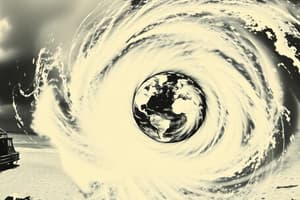Podcast
Questions and Answers
What defines climate as opposed to weather?
What defines climate as opposed to weather?
- Weather is only concerned with temperature fluctuations.
- Weather is determined by predictable trends over decades.
- Climate refers to short-term atmospheric conditions.
- Climate refers to average weather conditions over a long period. (correct)
Which of the following statements about storms is true?
Which of the following statements about storms is true?
- Storms are caused exclusively by anticyclones.
- All storms bring fair weather.
- Each type of storm has associated weather conditions. (correct)
- Thunderstorms and hurricanes are the only types of storms.
What is the primary function of sophisticated computer models in weather forecasting?
What is the primary function of sophisticated computer models in weather forecasting?
- To predict only long-term weather trends.
- To simulat atmospheric conditions and create future weather projections. (correct)
- To analyze current weather conditions without any prediction.
- To measure the exact temperature at all times.
How do global weather patterns influence local conditions?
How do global weather patterns influence local conditions?
What kind of damage can extreme weather events cause?
What kind of damage can extreme weather events cause?
What does weather primarily refer to?
What does weather primarily refer to?
Which of the following is NOT a factor influencing weather?
Which of the following is NOT a factor influencing weather?
What type of weather is typically associated with low pressure systems?
What type of weather is typically associated with low pressure systems?
Which instrument is used to measure wind speed?
Which instrument is used to measure wind speed?
Which type of cloud is most commonly associated with thunderstorms?
Which type of cloud is most commonly associated with thunderstorms?
What are fronts in meteorology?
What are fronts in meteorology?
Which cloud type has a flat, layered shape, often leading to overcast skies?
Which cloud type has a flat, layered shape, often leading to overcast skies?
What effect does high humidity have on temperature perception?
What effect does high humidity have on temperature perception?
Flashcards
Anticyclones
Anticyclones
Rotating weather systems with high atmospheric pressure at their center. They bring fair weather.
Storms
Storms
Weather systems characterized by strong winds and heavy precipitation. They can be associated with significant weather events like thunderstorms, tornadoes, and hurricanes.
Weather Forecasting
Weather Forecasting
The process of predicting future weather conditions based on current data and sophisticated computer models that simulate atmospheric conditions.
Climate
Climate
Signup and view all the flashcards
Weather
Weather
Signup and view all the flashcards
What is weather?
What is weather?
Signup and view all the flashcards
What is wind?
What is wind?
Signup and view all the flashcards
What is humidity?
What is humidity?
Signup and view all the flashcards
What is a cyclone?
What is a cyclone?
Signup and view all the flashcards
What is a front?
What is a front?
Signup and view all the flashcards
What are clouds?
What are clouds?
Signup and view all the flashcards
What does a barometer measure?
What does a barometer measure?
Signup and view all the flashcards
What does a thermometer measure?
What does a thermometer measure?
Signup and view all the flashcards
Study Notes
Introduction to Weather
- Weather describes the short-term state of the atmosphere at a specific time and location.
- Weather is constantly changing and influenced by factors like temperature, precipitation, wind, humidity, and atmospheric pressure.
- Global atmospheric circulation patterns (Hadley cell, Ferrel cell, polar cell) affect weather patterns.
- Weather systems (e.g., cyclones, anticyclones) impact local conditions.
Factors Affecting Weather
- Temperature: Measured in Celsius (°C) or Fahrenheit (°F). Influences clothing choices, precipitation types/amounts, and comfort.
- Precipitation: Any water falling from the atmosphere (rain, snow, sleet, hail). Amount and type vary regionally and seasonally.
- Wind: Horizontal air movement, measured in km/h or mph. Wind direction and speed are crucial for forecasts.
- Humidity: The amount of water vapor in the air. High humidity causes warmer perceived temperatures and contributes to clouds and precipitation.
- Atmospheric pressure: The force of air's weight. Changes relate to weather shifts. Low pressure often brings storms; high pressure, fair weather.
Measuring Weather
- Thermometer: Measures temperature.
- Barometer: Measures atmospheric pressure.
- Anemometer: Measures wind speed.
- Rain gauge: Measures precipitation.
- Hygrometer: Measures humidity.
- Weather stations: Collects various weather data for forecasts.
- Satellites: Observe global weather patterns and systems.
Types of Clouds
- Clouds are water droplets or ice crystals in the atmosphere.
- Different cloud types are linked to various weather conditions.
- Key cloud types include cumulus, stratus, cirrus, nimbus, and cumulonimbus, each with distinct shapes and altitudes.
Weather Systems
- Fronts: Boundaries between air masses with different temperatures and densities. Cold fronts often cause thunderstorms; warm fronts, milder conditions.
- Cyclones: Rotating systems with low pressure centers. Bring strong winds, heavy precipitation, and potentially significant weather events.
- Anticyclones: Rotating systems with high pressure centers. Associated with fair weather.
- Storms: Includes thunderstorms, tornadoes, and hurricanes. Each storm type has unique characteristics.
Weather Forecasting
- Forecasting predicts future weather based on current data and models.
- Complex computer models use data from multiple sources to simulate and project atmospheric conditions.
- Forecasts range from short-term (hours to days) to long-term (seasons to years).
Climate vs. Weather
- Climate: Average weather conditions over a long period (decades or more). Determines typical weather trends in a location.
- Weather: Short-term atmospheric conditions.
Global Weather Patterns
- Global patterns arise from Earth's tilt, rotation, and land/water distribution. These affect temperature, precipitation, and wind patterns worldwide.
Effects of Weather
- Weather influences human activities (transportation, agriculture, recreation).
- Extreme weather events (floods, droughts, hurricanes, tornadoes) cause significant damage and disruptions.
Studying That Suits You
Use AI to generate personalized quizzes and flashcards to suit your learning preferences.




